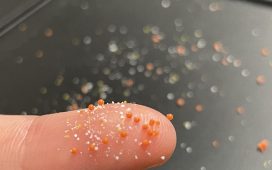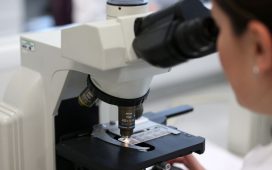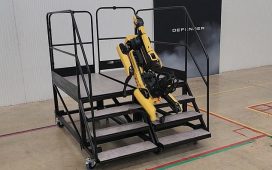From breaking down toxins to changing the inner workings of the human mind, mushrooms are capable of some seriously impressive features.
But now, researchers have taken a fungi’s amazing abilities to a new level as they teach a mushroom to crawl in a robot body.
Scientists from Cornell University in New York have created a new type of ‘biohybrid robot’ which puts the humble mushroom in the driver’s seat.
Natural electrical signals in the mushroom that are triggered by light are able to control the hybrid device’s insect-style legs.
The researchers say that robots of the future could make use of these fungal brains to respond to navigate more unpredictable environments.
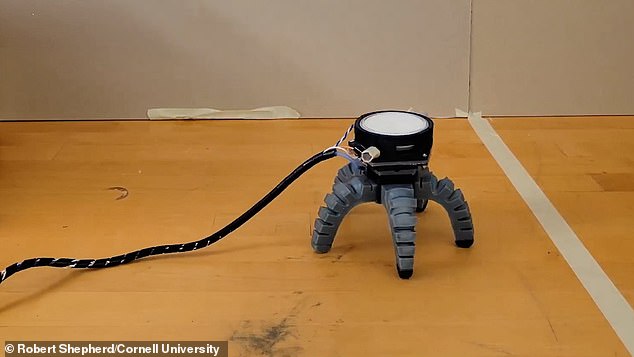
Natural electrical signals in the mushroom that are triggered by light are able to power the hybrid device’s insect-style legs
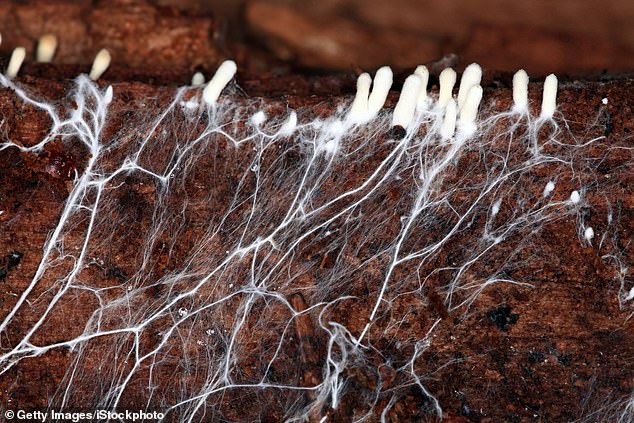
Researchers from Cornell University have created a system which uses a mushroom’s mycelium (pictured) to control a walking robot
Co-author Professor Rob Shepherd, head of Cornell’s Organic Robotics Lab, says: ‘This paper is the first of many that will use the fungal kingdom to provide environmental sensing and command signals to robots to improve their levels of autonomy.’
Although mushrooms might be what comes to mind when we think about fungus, these are really just the tip of the iceberg.
A mushroom is just the fruiting body of a much larger underground network of hair-like structures called mycelia which make up most of the mass of a fungus and can be some of the largest organisms on the planet.
But thanks to their incredible properties, these vast networks of fibres are also a perfect base for biological robots.
Fungus naturally creates electronic signals which travel through ionic channels very similar to those found in the brain’s neurons.
They are also capable of responding to chemical and biological signals and even reacting to stimuli in the environment.
The researchers made use of these natural characteristics to make the mycelium function like a simple brain for the robot.
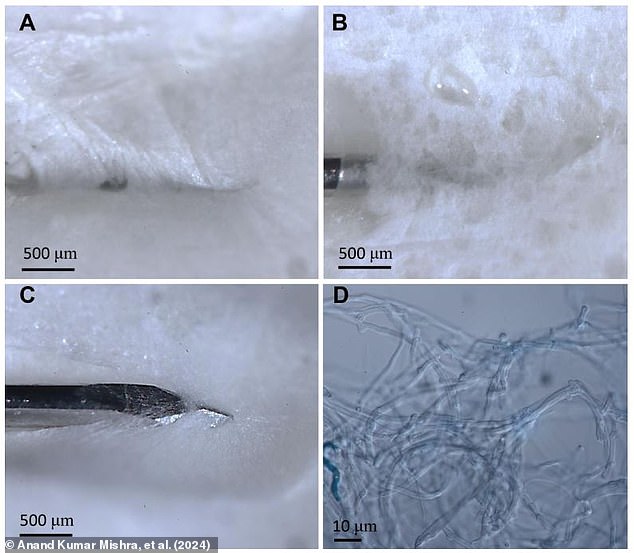
Mycelium is able to produce natural electrical signals and respond to stimuli in its surroundings, the researchers recorded these signals by growing mycelia around electrodes (pictured)
Petri dishes of mycelium are placed in an interface which blocks out any outside interference and carefully records the natural electrical activity.
This raw signal is processed to pick out the mycelia’s rhythmic spikes which are then converted into a signal which is used to control the robot’s motors.
Since fungus is photosensitive, when strong light hits the mycelium this triggers a change in the electrical activity which sends commands to the robot.
That allows the natural activity of the mushroom to pilot the robot and respond to the world around it, even if the fungus isn’t strictly aware of what it is doing.
Using this system, the researchers created two robots – a soft, starfish-like robot that walks on five legs and a larger robot that uses wheels.
When hit by an ultraviolet light the fungi changed its walking pattern accordingly, showing how hybrid robots are able to respond to stimuli.
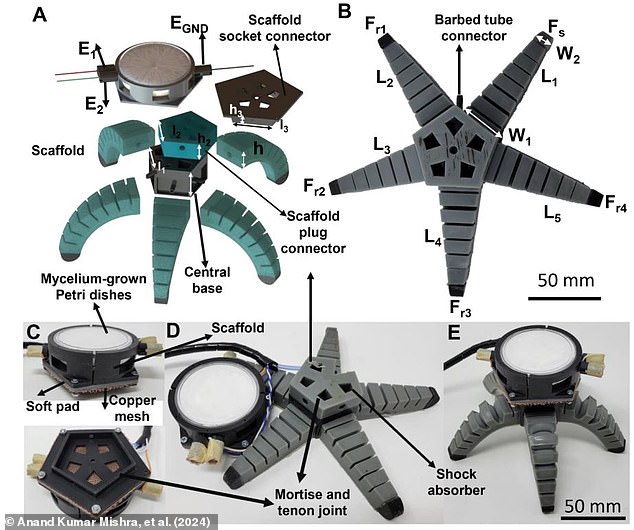
A specialised housing containing a mycelium sample is built into a soft robot to act as the walking device’s brain
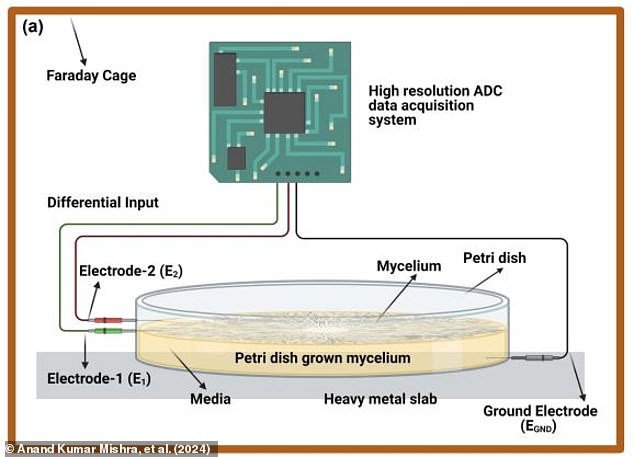
The raw signals from the mycelium (illustrated) are processed to find the natural rhythmic spikes, these are then converted into a control signal for the robot
Professor Shephard says: ‘By growing mycelium into the electronics of a robot, we were able to allow the biohybrid machine to sense and respond to the environment.’
Since mycelium is capable of responding to so many different types of stimulus, the potential uses for this technology are vast, according to the team.
‘In this case we used light as the input, but in the future it will be chemical,’ says Professor Shephard.
‘The potential for future robots could be to sense soil chemistry in row crops and decide when to add more fertilizer, for example, perhaps mitigating downstream effects of agriculture like harmful algal blooms.’
Fungal biohybrids also have the potential to open up more challenging environments to robots.
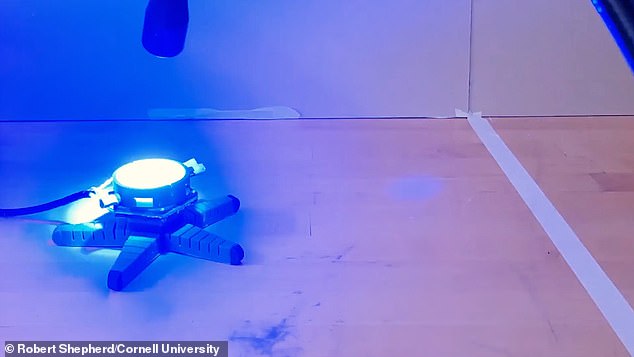
When ultraviolet light was shone on the mycelium it reacts to this stimulus and changes its signals, this allows the mycelium to change the robot’s gate
Lead author Dr Anand Mishra says: ‘Living systems respond to touch, they respond to light, they respond to heat, they respond to even some unknowns, like signals.
‘We can leverage these living systems, and any unknown input comes in, the robot will respond to that.’
In the past, scientists have used living cells like neurons to create biological computers capable of conducting simple tasks like playing the video game Pong.
Unlike a petri dish full of living cells, mycelium is extremely tough and can thrive in even the harshest conditions.
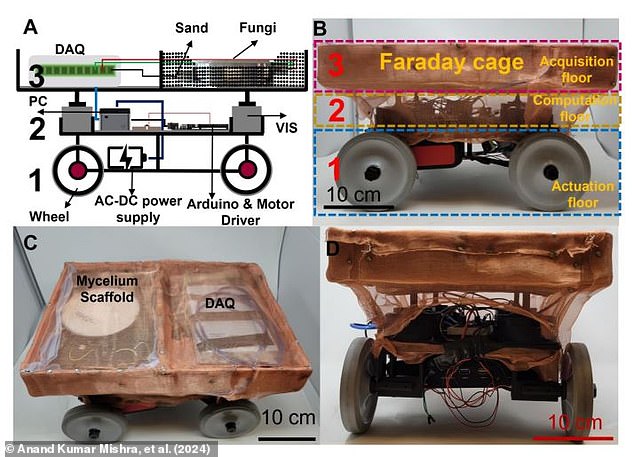
The researchers also created a wheeled robot which uses the mycelium control system to drive around and respond to light
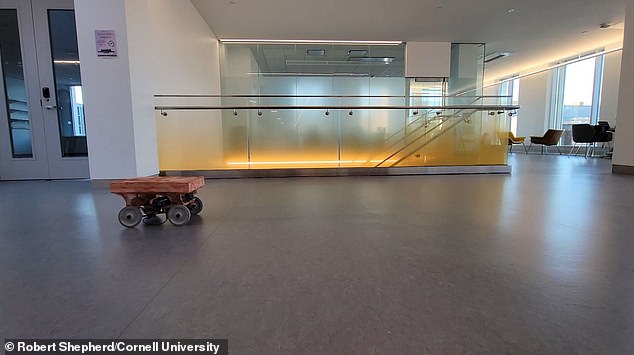
In the future, the researchers say that mycelium hybrid robots could be used in more complex environments and gain more autonomy
The researchers say that this could make biological robots a practical option for a far wider range of environments and situations.
However, Dr Mishra also believes that the implications of this study go beyond robotics.
Rather, he says that these sorts of robotic systems can help us understand non-human life on a deeper level.
By giving a fungus a body, we can physically see how it responds to stimulus or stress in a way that otherwise wouldn’t be possible.
Dr Mishra says: ‘This kind of project is not just about controlling a robot, it is also about creating a true connection with the living system.’


